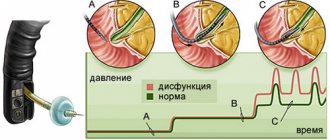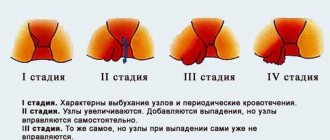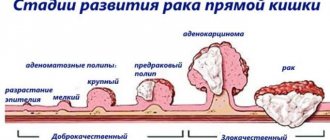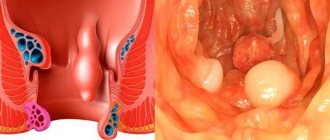Diagnosis is relevant when poor nutrition, stress, physical inactivity and other reasons have led to disturbances in the functioning of organs. This also applies to problems with the intestines, which already poorly digest food and absorb nutrients. Its x-ray examination allows us to determine the condition and causes. All that a regular x-ray often cannot do.
Pros and cons of the small intestine X-ray procedure
Examination using X-ray equipment with a contrast agent makes it possible to detect a greater number of diseases with minimal risk of injury. The substance is not absorbed into the blood and does not cause allergic reactions. The patient receives a reduced safe level of radiation compared to using a CT scanner. In addition, such X-ray installations provide an individual dose of the flow and its focusing on the observation area.
During such an examination, the small intestine is visible on the monitor screen. Additionally, targeted photographs are taken from the required angles, the quality of which is higher. Conventional x-rays provide insufficient visibility of intestinal “loops”. The safety of the fluoroscopic procedure is higher, since a special probe is not inserted into the intestine. The method makes it possible to unambiguously identify destructive changes in the mucous membrane.
The quality of targeted images and images on the screen may be reduced due to the patient’s failure to complete preparatory measures. Skilled introduction of a radiopaque composition into the lumen of the small intestine makes the procedure uncomfortable, but without pain. This examination is carried out after routine examinations of the digestive tract, since the contrast composition remaining in the body can mask the real picture.
What is the essence of this research method?
The fluoroscopy technique involves irradiating the area of the body to be examined with x-rays. Radiation allows you to show a picture of what is happening inside the body, which is recorded on an x-ray. Obtaining an image using an x-ray is called radiography.
To perform an X-ray examination, a contrast agent – barium – is used. It is not barium itself that is used, but its sulfate (sulfate salt), since it is non-toxic. Contrast is necessary to increase the contrast of the photo and get a clear image.
- If a fluoroscopic examination of the upper gastrointestinal tract (esophagus, stomach and small intestine) is to be performed, the patient is given a barium suspension (a mixture prepared in the proportion of 80 grams of barium sulfate per 100 milliliters of water) to drink. If necessary, double contrast can be used - sodium citrate and sorbitol are added to the suspension.
The passage of barium occurs from top to bottom.
The passage of barium sulfate through the intestines occurs as follows. After an hour, the contrast reaches the small intestine. After three hours it is in the transition between the small and large intestines. Within six hours, barium enters the ascending colon. After twelve hours it reaches the sigmoid colon, and after 24 hours it reaches the rectum.
Thus, the normal passage time is approximately a day.
During irrigoscopy, the solution is administered through the rectum
- In this regard, for X-ray diagnostics of the lower sections - the colon and rectum (irrigoscopy, irrigography) enemas are used (according to the instructions - 750 grams of barium per liter of a half-percent tannin solution).
The resulting image is examined and analyzed by a radiologist. Based on the results of the analysis, he writes a conclusion, which is sent to the attending physician.
Some people are afraid of procedures using x-rays. They are afraid that radiation may cause cancer. There is no need to be afraid of this.
Modern radiology is at a high enough level to ensure the safety of the person being examined.
X-ray examination of the gastrointestinal tract is not performed quickly (sometimes it takes several hours). Does it hurt? No, although some discomfort is felt. However, there is much less discomfort than, for example, during an endoscopic examination. Therefore, not only an adult, but also a child can endure the procedure without any problems.
Indications for use
The list of manifestations and complaints confirming the presence of pathological changes in the small intestine includes vomiting with blood, a noticeable reduction in body weight, black stool (without a special diet), diarrhea, and constipation. Fluoroscopy is also appropriate when there is difficulty swallowing, persistent heartburn, and constant pain in the epigastric region. Instrumental examination is indicated to detect in the intestines:
- inflammation of enteritis;
- muscle motility disorders;
- obstruction, narrowing;
- malabsorption syndrome;
- chronic colitis;
- suspected ulcer, cancer;
- nonspecific ulcerative colitis;
- diaphragmatic hernias, etc.
X-ray examination
At the slightest suspicion of intestinal obstruction, it is necessary to take an x-ray of the abdominal cavity.
To begin with, they only do a survey fluoroscopy, during which a diagnosis can be made based on certain signs. X-ray is the main method of examining the intestines. There are 5 main signs of intestinal obstruction:
- intestinal arches;
- Kloiber's cup;
- absence of gases in the intestines;
- transfusion of fluid from one loop of intestine to another;
- striation of the intestine in the transverse direction.
Contraindications to the procedure
Examinations are not recommended during pregnancy. Particular caution is exercised when there is a suspicion of intestinal obstruction, since the radiocontrast agent may enhance it. The study is contraindicated if:
- ulcerative colitis (rapid destructive process);
- fresh biopsy of the large intestine;
- toxic megacolon;
- suspicion of perforation of the intestinal wall;
- tachycardia and severe heart failure;
- intense unbearable abdominal pain;
- unconscious or serious condition of the patient, etc.
Consequences
There may be problems with bowel movements (constipation) and indigestion due to barium intake. Several days after the procedure, the patient's stool may turn grayish or white. If the described symptoms become protracted or other changes in the gastrointestinal tract are observed, then you should urgently consult your doctor.
After the examination is completed, the patient may experience some problems:
- constipation;
- metabolic disease;
- The stool may turn grayish or even white.
If the listed symptoms are long-lasting, and significant problems arise in the gastrointestinal tract, the patient should immediately consult a doctor.
To effectively remove barium sulfate from the body, after the examination you must drink at least two liters of still water. In order for the liquid to dissolve the suspension faster, it is recommended to drink 1.5 liters of water for a few more days.
Loading …
How to prepare?
The doctor clarifies that there is no allergy to the contrast agent and iodine-containing drugs, and information about recent exacerbations of chronic diseases. The doctor is informed about all medications that are taken. As a rule, medications that slow down intestinal motility are discontinued the day before. A day or two before the procedure, the prescribed diet is followed, excluding fruits and vegetables, foods that promote gas formation (vegetables, brown bread, cream, milk).
The amount of liquid you drink should be at least 2 liters per day. The day before the procedure, it is recommended to give up solid food and smoking, and liquids should be clear (juices without pulp, broths, tea). The night before, the patient drinks a laxative. No liquids will be accepted after midnight. After complete bowel movements, you should do at least 2 more enemas with warm boiled water (castor oil or magnesium sulfate) and one the next morning.
You can use activated carbon for cleansing. It is taken 2 tablets 4 times a day. A warm water enema is given before bed and in the morning. It should be ensured that there is a return exit with clean liquid.
Enema-free preparation is carried out using the Fortrans powder composition. In agreement with the doctor, 1-3 packets of the composition are taken depending on body weight. The X-ray procedure is performed on an empty stomach. Before starting the procedure, all metal objects are removed.
Features of an X-ray examination of the intestine
Carrying out an X-ray of the intestines requires preliminary preparation, compliance with certain rules of behavior directly during the procedure and after its completion.
Important! If the patient is taking medications or has an allergy to any substance (including barium), then he must tell the doctor about it. Some drugs can slow intestinal motility.
Preparatory stage
The diagnosis will take place without complications and discomfort, and the results of an X-ray of the intestine will be more reliable if the organ is thoroughly cleansed. To do this, it is recommended to follow a diet, as well as cleanse the intestines using enemas or special pharmacological preparations.
Fruits and grains
Dietary nutrition should be followed 2-3 days before the scheduled examination. To do this you will need:
- remove from the diet foods that contribute to the formation of a large amount of gases or take a very long time to digest (dairy, legumes, fatty foods, carbonated drinks, nuts, several types of vegetables and others);
- Avoid drinking alcohol and smoking (if you can’t give up cigarettes completely, then reduce their quantity);
- one day before the X-ray examination, remove all solid food (you can drink broth, juices, decoctions);
- During the diet you need to drink plenty of fluids.
Advice! If you forget to monitor the amount of liquid you drink, then in the morning pour 2 liters of water into a jar and place it in a visible place. As soon as you see it, immediately drink in large sips as much as you can (even if you are not thirsty). It should be empty by evening.
A day before the procedure, you need to start giving cleansing enemas. You can add magnesia or castor oil to the water. If you plan to use pharmacological drugs, it is better to first discuss this issue with your doctor. He will tell you how to cleanse your intestines before an x-ray using medications, and which one is best for you. Fortrans is usually used for this purpose.
On the day of the x-ray, you should not eat or drink anything, starting at midnight. It is advisable to do a control enema early in the morning; the water should be absolutely clear.
Progress of the procedure
If a patient encounters this diagnostic method for the first time, then, of course, he is concerned with the question of how to do an X-ray of the intestine. First you need to remove metal objects from yourself and change into a special shirt. If diagnostics is also required for the thin section, then you will need to drink a barium solution (about half a liter); if only the thick section needs to be examined, then the person is laid on a couch and the solution is injected through the anus.
Liquid is introduced slowly into the rectum, achieving its uniform distribution in the intestinal lumen by periodically turning the patient from one side to the other.
Important! Proper deep breathing will help eliminate unpleasant pressure sensations.
Air is introduced after the liquid. During the procedure, photographs are taken and/or the process is observed on a monitor. You will need to hold your breath while the image is being taken.
What to do after the procedure
After the intestinal x-ray is completed, the patient changes clothes and goes home. In some cases, a specialist does the decoding and hands over the results.
Within 2-3 days after diagnosis, the stool will have a light shade (up to white). At this time, you need to drink plenty of water, as barium provokes constipation. Some may need to take additional laxatives.
Be sure to continue to follow a diet in the first days after the x-ray. Exposure of the cleansed intestinal walls to fatty, spicy and hard foods can lead to serious gastrointestinal problems. Therefore, the transition to the usual diet should be gradual. If you experience abdominal pain, severe gas formation, or difficulty defecating for several days, you should definitely consult a doctor.
How is the small intestine x-ray procedure performed?
Before the procedure, the patient drinks a barium sulfate solution (500 ml).
The patient drinks a weighed solution of barium sulfate (500 ml), which after 1/4 hour reaches the small intestine, and after 2 – 5 hours the procedure begins. Another option is to use a Bobrov container (1 l) filled with barium diluted with water. The patient is fixed in a supine position on a moving table. Air is pumped into the jar through a tube.
The liquid is slowly introduced through the exit tube under minimal pressure through the anus into the digestive tract. Uniform distribution of the suspension along the walls of the tract is achieved by slowly turning the patient from side to side. Double contrast (increases the quality of the images) is carried out by gradually filling the intestines with air. Feelings of pressure are relieved by deep breathing.
The small intestine and other sections are studied for about 30 minutes. The doctor observes peristalsis and the condition of the mucous membrane on the monitor due to the passage of the substance. Places with pronounced changes are precisely photographed (about 8 pictures are taken) in different positions of the table. Its movement changes the filling of organs with a contrasting composition.
If the filling is low, the relief of the inner surface and the folds of the mucous membrane are assessed. When strong - the position, shape, size, contours, displacement and functions of the organ. The study is completed when the passage of the substance reaches the cecum. Depending on the condition, the doctor may recommend bed rest (enemas, laxatives) or allow a normal lifestyle and diet. The contrast mixture is excreted in the form of colorless feces for 2–3 days.
What is a barium x-ray?
A barium X-ray is an examination that allows you to obtain not only a detailed image of the stomach, but also the entire gastrointestinal tract.
The procedure is based on the introduction of barium sulfate. With the help of barium, you can carefully study the shape and relief of internal organs, as well as identify pathological changes. The procedure occurs after the patient has taken the contrast agent orally. During the examination, the radiologist will examine the upper gastrointestinal tract and take a series of x-rays.
What do the results show?
The passage of the substance and air make it possible to observe the shape and structure of the organ, detect inflamed areas and neoplasms. Coating the intestinal walls with the injected composition ensures clear plastic images of the folds of the inner surface. It is normal when the pictures show a speckled image, pathology is when the substance is in the form of flakes (poor absorption syndrome, lymphogranulomatosis, lymphosarcoma, etc.).
Dense placement of the composition shows the external contours of the walls and filling defects - assesses the possibility of ulcerative defects, wall cancer, the presence of fistulas, tumors, scars, diagnoses the relief of the mucous membrane, the diameter of the lumen of the colon, its shape, location, etc.
A specialist determines the extensibility, mobility and elasticity of the walls. Of great importance is the assessment of the relief of the intestinal mucosa, the motor function of the colon, its displacement and elasticity.
When is the procedure indicated?
The examination is carried out if diseases and pathologies are suspected that may pose a serious danger to the patient. In most cases, barium X-ray of the stomach allows you to confirm or clarify the diagnosis and prescribe the correct treatment.
Peptic ulcer of the stomach and duodenum (DPC) leads to the periodic appearance of ulcers. It can take years to develop and cause serious harm to health. Using a barium X-ray of the stomach, the specialist finds the ulcer and evaluates its size, shape and other parameters, as well as establishes the stage of the disease and detects accompanying symptoms.
If the development of a malignant process is suspected, an X-ray of the stomach with barium is recommended without fail, since the consequences of the disease can be deadly for the patient. In the photographs, the cancerous process looks like a defect in the mucous membrane. Often, after a barium X-ray of the stomach, an endoscopic examination is performed and a sample of the tumor is taken for laboratory testing.
To diagnose wall protrusion (diverticulosis), a barium X-ray of the stomach requires additional preparation. After administration of the contrast agent, the patient alternately lifts the upper and lower parts of the body so that the contrast fills the entire organ cavity.
On a barium X-ray of the stomach, small diverticulosis looks like an ulcer, but has a horizontal level and a neck.
Foci of inflammation in the stomach can appear as a result of various processes. Including peptic ulcers or oncology. An X-ray of the stomach with barium allows you to find the source of inflammation and, based on indirect signs, determine its cause.










